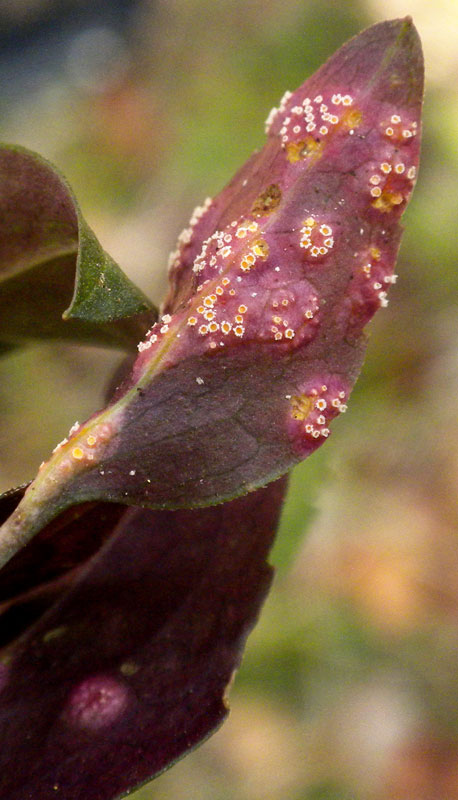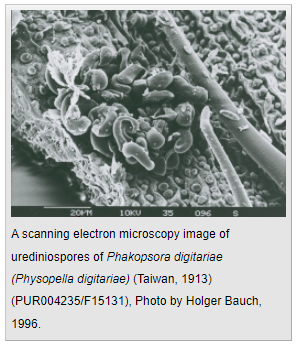What Are Rust Fungi?

Rust fungi (Pucciniales, formerly Uredinales) belong to subphylum Pucciniomycotina, which is considered the earliest diverging lineage in Basidiomycota (Aime et al. 2014; Padamsee et al. 2012). Other subphyla of Basidiomycota include mushroom-forming fungi (Agaricomycotina) and the smut fungi and their allies (Ustilaginomycotina). All rust fungi are parasites of plants, and they are found in all areas where plants grow, including high altitudes and deserts (Arthur 1934; Savile 1971; Smith et al. 2004). The hosts of rust fungi range from ferns and conifers to monocots and dicots. Despite the generally wide host range, as a result of a long co-evolution with plants, most rust fungi are specific to their hosts (Duplessis et al. 2011; Savile 1971). Rust fungi have by far the most complex life cycles within the fungal kingdom and probably among eukaryotes. The general rust fungus life cycle requires five different spore stages and alternation between two taxonomically unrelated host plants for completion. Moreover, at ca. 8000 described species, they also represent the largest natural group of phytopathogens. Pucciniales are obligate parasites, meaning that they need a living host plant for development.

In monocultural ecosystems, rust fungi may cause considerable damage to their hosts and are therefore important pathogens in agricultural, horticultural and industrial forest habitats.Thus, rust fungi can cause severe diseases in our most important crops. Some examples are: the rusts of wheat, corn and other cereals; forage and range grasses and sugar cane; beans, soybeans, peanuts, and other legumes; various fruits and vegetables; coffee, forest and plantation timber, and pulp trees.

The taxonomy of rust fungi has been based primarily on morphology of certain spore stages (Petersen 1974; Ramsbottom 1912; Sato and Sato 1985). The majority of the taxonomic studies on American rust fungi have been conducted at Purdue University. The present classification system divides rusts into 14 families, with some genera of uncertain affinity (Cummins and Hiratsuka 2003; Minnis et al. 2012). The application of molecular methods to refine taxonomy has not been as widely applied in rust fungal systematics as it has for other groups of Fungi. However, the last 20 years have seen the publication of several phylogenetic studies that are advancing our knowledge of rust fungi evolution (Aime 2006; Maier et al. 2003; Wingfield et al. 2004).
Aime MC. 2006. Toward resolving family-level relationships in rust fungi (Uredinales). Mycoscience 47: 112–122. Link here.
Aime MC, Toome M, McLaughlin DJ. 2014. 10 Pucciniomycotina. In: McLaughlin D., Spatafor J. (eds) Systematics and Evolution. The Mycota vol 7A. Springer, Berlin, Heidelberg. Link here.
Arthur JC. 1934. Manual of the Rusts in United States and Canada. Purdue Research Foundation, Lafayette. 438 pp.
Cummins GB, Hiratsuka Y. 2003. The Illustrated Genera of Rust Fungi. APS Press, St. Paul, Minnesota. 225 pp.
Duplessis S, Cuomo CA, Lin Y-C, Aerts A, Tisserant E, Veneault-Fourrey C, Joly DL, Hacquard S, Amselem J, Cantarel BL, Chiu R, Coutinho PM, Feau N, Field M, Frey P, Gelhaye E, Goldberg J, Grabherr MG, Kodira CD, Kohler A, Kües U, Lindquist EA, Lucas SM, Mago R, Mauceli E, Morin E, Murat C, Pangilinan JL, Park R, Pearson M, Quesneville H, Rouhier N, Sakthikumar S, Salamov AA, Schmutz J, Selles B, Shapiro H, Tanguay P, Tuskan A, Henrissat B, Vande Peer Y, Rouzé P, Ellis JG, Dodds PN, Schein JE, Zhong S, Hamelin RC, Grigoriev IV, Szabo LJ, Martin F. 2011. Obligate biotrophy features unraveled by the genomic analysis of rust fungi. Proceedings of the National Academy of Sciences. 108: 9166–1971. Link here.
Maier W, Begerow D, Weiss M, Oberwinkler F. 2003. Phylogeny of the rust fungi: an approach using nuclear large subunit ribosomal DNA sequences. Canadian Journal of Botany 81: 12–23. Link here.
Minnis AM, McTaggart A, Rossman A, Aime MC. 2012. Taxonomy of mayapple rust: the genus Allodus resurrected. Mycologia. 104: 942–950. Link here.
Padamsee M, Kumar TKA, Riley R, Binder M, Boyd A, Calvo AM, Furukawa K, Hesse C, Hohmann S, James TY, LaButti K, Lapidus A, Lindquist E, Lucas S, Miller K, Shantappa S, Grigoriev IV, Hibbett DS, McLaughlin DJ, Spatafora JW, Aime MC. 2012. The genome of the xerotolerant mold Wallemia sebi reveals adaptations to osmotic stress and suggests cryptic sexual reproduction. Fungal Genetics and Biology. 49: 217–226. Link here.
Petersen R. 1974. The rust fungus life cycle. The Botanical Review. 40: 453–513. Link here.
Ramsbottom J. 1912. Some notes on the history of the classification of the Uredinales. Transactions of the British Mycological Society. 4: 77–105. Link here.
Sato T, Sato S. 1985. Morphology of aecia of the rust fungi. Transactions of the Britisih Mycological Society. 85: 223–238. Link here.
Savile DBO. 1971. Coevolution of the Rust Fungi and Their Hosts. The Quarterly Review of Biology. 46: 211–218. Link here.
Smith JA, Blanchette RA, Newcombe G. 2004. Molecular and morphological characterization of the willow rust fungus, Melamsora epitea, from arctic and temperate hosts in North America. Mycologia 96: 1330–1338. Link here.
Wingfield GD, Ericson L, Szaro T, Burdon JJ. 2004. Phylogenetic patterns in the Uredinales. Australasian Plant Pathology. 33: 327–335. Link here.
